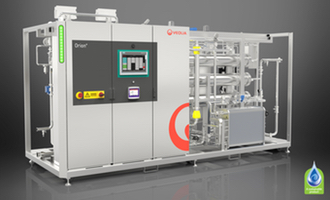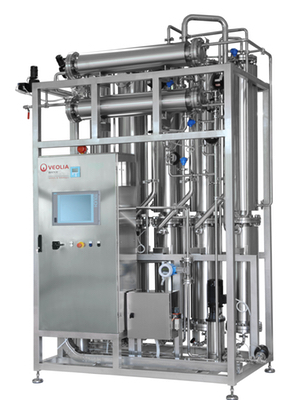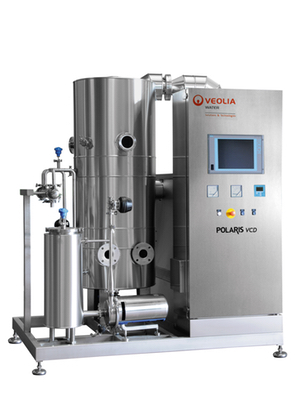Of the various different qualities of water used in the pharmaceutical industry, the most critical is Water for Injection (WFI). This is the water that is used for the manufacture of parenteral solutions; products such as vaccines and intravenous drips that are injected directly into the body. The quality of WFI is prescribed in the three principal pharmacopoeias – the US, European and Japanese – and they are in broad agreement: conductivity <1µS/cm, total organic carbon (TOC) <0.5mg/l, total bacteria count <10cfu/100ml and endotoxins <0.25EU/ml. Where they have differed is in the method of production. While the US and Japanese pharmacopoeias accept distillation or reverse osmosis, the European Pharmacopoeia (Ph. Eur.) has always insisted on distillation. But that is about to change.
A revision to the Ph. Eur. Monograph 169 Water for Injection allows, from April 2017, production “by distillation … or by a purification process that is equivalent to distillation. Reverse osmosis (RO), which may be single-pass or double-pass, coupled with other appropriate techniques such as electro-deionisation, ultrafiltration or nanofiltration, is suitable”. This brings Ph. Eur. in line with the US and Japanese pharmacopoeias, but what does it mean for pharmaceutical engineers?

Orion packaged Purified Water system
Distillation vs RO
The reason that distillation was originally specified for WFI is that there is a phase change from liquid to vapour; the only way endotoxins can be carried is in water droplets, so in the vapour stage the distiller is designed to remove any prevailing water droplets before the vapour is condensed to WFI water. This is a very effective method of purification, and the operating temperature of a multiple effect still ensures that the product water is compliant with microbial and endotoxin limits. This makes distillation reassuring from the operational viewpoint and for those companies who need, or simply prefer, to store and distribute hot WFI, it is the automatic choice. However, in most systems the heat source is steam – often clean steam – and this means that distillation plant has to be engineered in compliance with the EU Pressure Equipment Directive, so its capital cost is significantly higher than that of RO plant.
The Monograph states that: “Water for injections in bulk is obtained from water that complies with the regulations on water intended for human consumption laid down by the competent authority or from purified water”.
Most pharmaceutical manufacturers use Purified Water, so the water is effectively treated twice, which means that operating costs are also higher. In fact, producing WFI by membranes is only marginally more expensive than techniques currently employed for producing Purified Water, so it may be worthwhile considering a membrane system to produce WFI and using this for all purposes where Purified Water or better is required.
Veolia’s Orion packaged Purified Water system has, as standard, single or twin pass RO, membrane degassing to remove dissolved carbon dioxide, volatile organics and oxygen, and final continuous electro-deionisation to achieve a conductivity of <1.0µS/cm at the point of use. It is fully heat sanitisable and, with the addition of an optional ultrafiltration module to ensure endotoxin removal, meets all the requirements of the new WFI Monograph.

Polaris multiple effect WFI still
Other benefits
Apart from the cost savings, membrane systems have a number of other benefits. They have a smaller footprint and because they operate at ambient temperature, present less of a hazard to operators. But it is not quite as simple as it sounds. Another factor to consider is that RO systems operate at ambient temperature, and this can lead to the formation of biofilms. These are notoriously difficult to remove and, because they protect micro-organisms from disinfection chemicals, can result in rapid re-growth and proliferation, as well as increasing the likelihood of microbiological by-products, such as endotoxins, throughout a system. Some membrane systems, including Veolia’s Orion, are designed to be heat sanitised and can control the formation of biofilms. But not all RO systems meet this criterion and it is imperative that the correct RO be used.
A further factor which might militate against a change from distillation is the requirement, written into the Monograph, that notice must be given to the supervisory authority of the manufacturer before implementation of a membrane system for both new and existing drug manufacturing protocols. This will involve extensive validation procedures and associated documentation.
Quality considerations
It may seem self-evident, but the Monograph states that: “For all methods of production, correct operation monitoring and maintenance of the system are essential. In order to ensure the appropriate quality of the water, validated procedures, in-process monitoring of the electrical conductivity, and regular monitoring of total organic carbon and microbial contamination are applied. The first portion of water obtained when the system begins to function is discarded. Water for injections in bulk is stored and distributed in conditions designed to prevent growth of micro-organisms and to avoid any other contamination.” This reinforces what is in the ISPE Baseline Pharmaceutical Engineering Guide on Water and Steam Systems.
Whichever production process is used, WFI has to be stored and distributed, and it is here that post-production contamination can occur. Even the best designed distribution systems are prone to bacterial growth, proliferating at around 20°C, so it is essential to minimise risks.
WFI can be distributed at a temperature above 70°C, when most bacteria will be destroyed, but this is not always practicable or even desirable.
Ambient temperature distribution loops should include UV and/or ozone dosing and allow for regular hot water sanitisation with every part of the system reaching a minimum of 80°C. This should include temperature monitoring around the distribution system to validate the sanitisation. Aside from temperature, the organic carbon content is a crucial factor for the growth of micro-organisms. The current compendial standard for TOC is 500µg/l but levels of less than 10µg/l minimise the likelihood of bacterial growth.
ISPE recommends on-line TOC meters located at various positions within the RO water system as a prerequisite to the control strategy, together with on-line conductivity monitors at the same points. Regular bacterial monitoring should use the latest rapid microbiological methods and trend data should be reviewed routinely to determine the potential for deterioration in the system.

Polaris vapour compression WFI stil
Finding the right balance
The choice of WFI production method is ultimately about finding the correct balance between cost and risk. On the basis of capital cost alone, membranes will usually win. The direct cost of utilities (power and water) are generally higher for distillation but add in the cost of regular sanitisation of the membranes plus multi-point on-line monitoring of TOC, conductivity and possibly rapid microbiological testing, and the difference may not be so great.
Then there is the operational risk of microbiological contamination.
The operating cost savings offered by this type of RO-based system are highly attractive and Veolia expects an increasing number of pharmaceutical manufacturers to be adopting this approach as a way to reduce operating costs without affecting the integrity of the system.
Any system for WFI production, regardless of technology, must be well designed by an experienced company in line with the current regulatory guidelines, correctly installed and then monitored and maintained to a high standard.
Ranj Rihal, Product & Marketing Solutions Business Development Manager, Veolia will present a paper on the subject at the ISPE 2017 Europe Annual Conference in Barcelona, 3-6 April 2017.
A guide to WFI Production Systems summarising the pros and cons of distillation and membranes is also downloadable at: wfi.veoliawatertechnologies.co.uk
